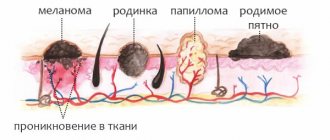Causes of papillomas
The main reason why a benign tumor forms is infection with the virus through domestic or sexual contact. HPV can remain in the body for years, but manifest itself under favorable conditions. Reasons that provoke neoplasms in different parts of the body or mucous membranes:
- weak immunity;
- stress, depression;
- long-term use of medications;
- frequent change of sexual partners.
The structure of papilloma and warts is stroma (base, island) with connective fibrous tissue. Localization - on the face, neck, eyelids, external genitalia, chest, armpits.
Why you shouldn’t tear it off and damage it
HPV sufferers are aware of the consequences of traumatizing elements and try to avoid cutting, picking and tearing out.
Papillomatosis is a disease that affects large areas of the body, where hanging and flat formations appear.
The danger comes from growths and moles on thin stalks located on the eyelids, groin, armpits and chest area.
A dangerous type is condylomas, which affect the genitals and butt (anus). They are transmitted sexually and can be injured during sexual intercourse. If damage occurs, the consequences will be negative.
Is it possible to tear off papillomas or cut them off?
Doctors recommend that if new growths are detected on the skin, seek medical help for accurate diagnosis and removal of growths; self-removal is not allowed. If a papilloma is torn off intentionally, the risk of infection or development of a malignant tumor increases.
What you can and cannot do if you have growths:
- You can apply powder, special creams, masks, scrubs that cleanse the skin.
- It is allowed to use proven drugs against papillomavirus.
- Is it possible to cut off papillomas? Rude interference is strictly prohibited.
- Why can't you tear off the growths? There is a high risk of developing a malignant tumor.
- It is necessary to avoid gross damage to the growths and avoid friction against the seams.
- Do not scratch or itch the skin. Hygiene procedures should be carried out very carefully.
There are situations when a strong body independently fights a skin disease.
A person may have a growth for several years, but one day it comes off painlessly. This means that the body has produced enough antibodies to fight the virus. In this case, there is no risk of degeneration into a malignant tumor; the location of the growth is dried out, without wounds, bleeding or inflammation. What happens if the papilloma is damaged intentionally:
- The formation is viral in nature; the causative agent is present in the skin growth in high concentration. Is it possible to cut off papillomas with scissors or a razor? In no case. Viral particles will quickly spread over the surface of the epidermis, and instead of one formation, a group will appear.
- If the virus strain is of the oncogenic type, the risk of the growth degenerating into a malignant tumor increases significantly. If a papilloma is torn off during water procedures or due to gross damage, you need to treat the wound and consult a doctor.
- The skin growth contains an infectious agent. If you intentionally touch the tumor, an inflammatory process will begin, accompanied by bleeding, swelling, redness, and pain. You absolutely cannot cut off a papilloma yourself.
- An inflammatory focus forms on damaged skin. Against the background of weak immunity, the consequences can be serious. Even if the stroma contains a strain of a non-oncogenic virus, the pathogenic agents will spread to neighboring areas of the skin.
What should a person do if he picks off a papilloma with his fingernail? Inspect the location of the growth. When signs of an inflammatory process are present, the damaged area must be treated with an antiseptic composition. All objects that came into contact with the affected skin surface must be disinfected. Next you need to undergo diagnostics by seeking advice from a specialist.
How can you accidentally remove, tear off, cut off a growth?
Most often, papillomas form in those places that receive the most mechanical impact: the face, neck, hands, intimate places. It is at these localizations that they are easiest to tear off.
On the face
On the face, papilloma can be located in any area: on the chin, cheeks, nose, forehead, eyelids. A person comes into contact with his face more than once during the day, so the growth can easily be torn off by accident.
This can happen when washing your face, using cosmetics (especially scrubs), removing pimples on your own, getting dressed and removing piercings near papillomas. You can even accidentally tear it off by scratching your face, for example, in your sleep. In addition, some perceive the formation as an ordinary pimple and purposefully try to get rid of it.
On the armpit
In this area, papillomas accidentally fall off during depilation. Sometimes a person simply forgets about the presence of a growth, and sometimes he does not calculate his strength and gets rid of papilloma by using a razor, epilator, wax strips, etc.
Papilloma in the armpit area can be removed by wearing uncomfortable underwear or tight clothing, especially during physical activity, when the seam constantly exerts a mechanical effect on the tumor, causing it to fall off. The shoulder strap of a backpack or bag can also rub a papilloma in the armpit.
Thread-like formations
On the neck
You can accidentally remove a papilloma on the neck in the shower, using a rough washcloth, actively combing, wearing jewelry, tight turtlenecks and clothes with a high narrow collar, scarves.
The tumor can be caught by a zipper on a jacket, squeezed by a bag strap, or damaged during hairdressing procedures or when combing.
In the intimate area
Papilloma in the intimate area can be damaged during getting rid of unwanted hair (razor, epilator, wax and sugar paste), intimacy and caresses, with strong pressure when using toilet paper, when scratching, active sports (cycling), wearing tight clothes. tight trousers.
Also, the risk of accidentally picking off a papilloma in an intimate place is higher in overweight people, when constant friction occurs when walking.
On other parts of the body
A papilloma can be accidentally torn off by any mechanical or chemical influence:
- Damage to clothing, linen.
- A fall or blow (for example, if you hit an elbow on which a papilloma has formed, it may fall off).
- Unconscious picking (scratching in a dream, during a serious conversation, etc.).
- Wearing jewelry.
- The use of various lotions, masks, body scrubs.
Thermal effects (burn), animal bites and other factors can also damage the tumor.
Accidental damage and its consequences
What happens if you pick off a papilloma not on purpose? It's better to avoid this. Most people infected with papillomavirus are aware that it is impossible to deliberately cut, pick, or tear off the stroma.
But there are situations when a person accidentally tears off a papilloma. Growths on thin fibers located in delicate places (in the armpits, under the breasts, on the eyelid) can be accidentally damaged. What happens if you tear off a wart:
- The virus is highly likely to spread to other parts of the body. It is quite possible for several formations to appear on the skin if a papilloma is accidentally torn off.
- An inflammatory process caused by an associated bacterial infection. If you accidentally pick off a papilloma, the damaged area will become red and inflamed.
- If a man cuts off a papilloma on his face while shaving, the razor cut is a wound site that becomes the cause of self-infection (autoinoculation). Cutting off a papilloma with a razor is also dangerous for another reason - the resulting wound becomes a direct site of infection and must be treated immediately.
- If a woman accidentally rips off a papilloma under her breasts, she needs to go to the doctor. Scientists suggest a connection between papillomavirus and cervical cancer.
- You can accidentally tear off a papilloma with clothing - the seams, sleeve edgings cling to the growth, the stroma can become inflamed from a blow or scratch.
The consequences in such a situation can be quite serious - damage to the epidermis opens the way for further spread of the viral infection, so tumor detachment can be accompanied by signs of inflammation, itching, pain, and discomfort. You cannot intentionally pick off a stroma, but if this happens by accident, you need to follow safety precautions so as not to infect others.
If you accidentally hit a papilloma while shaving, the wound needs to be disinfected. After which, consult a doctor.
What happens if the papilloma comes off, getting caught in the tissue? When the process occurs painlessly under the influence of clothing, and there is no visible damage to the skin at the site of the growth, there is no need to worry - the body has dealt with it on its own. Some people wonder if it is possible to tear off papillomas if they come off? It’s still impossible - when the moment comes, the growth will fall off on its own.
What to do if a papilloma comes off
Skin diseases cannot be ignored so as not to harm your own health. The virus in the body does not necessarily have a high oncogenic risk, but this cannot be excluded before undergoing diagnosis. Timely diagnosis and treatment help prevent a situation where a growth degenerates into a malignant one.
What will happen if you tear off the papilloma is clear - the disease will progress, new growths will appear on the skin. If a person accidentally damages a tumor, the damaged area should be treated.
Procedure if you pick off, cut, or tear a papilloma:
- Inspect the damaged area of the skin.
- Treat the wound with an antiseptic.
- Disinfect contact surfaces.
- Visit the diagnostic center and get tested.
- Consult a doctor for skin diseases.
Women often wonder what to do if they tear off a papilloma under the breast or on the back with underwear? You need to examine the wound for inflammation - if there are no signs of infection, there is no need to worry. If the papilloma is torn out, bleeding, the tissues are swollen - this is the beginning of the inflammatory process.
How to treat a wound
To prevent the penetration of infection that provokes the inflammatory process, it is necessary to properly and promptly treat the wound received during the injury. Conditions should be created for rapid healing of the wound, without leaving scars. Treatment of the affected area:
- carefully inspect the damaged area;
- if there is bleeding, stop it by applying a bandage soaked in hydrogen peroxide. Apply the compress for 15 minutes;
- You can clean the wound with alcohol or an antiseptic, or, in extreme cases, with iodine or brilliant green;
- the wound should be sealed with a sterile cloth bandage using an adhesive plaster, which will reduce the penetration of bacteria;
- It is not recommended to peel off the crust; it should fall off on its own;
- if a piece comes off, put it in saline solution and take it for histology to eliminate the risk of degeneration.
Diagnostics will help determine the malignant nature of the growth, and the doctor will advise the correct method for removing the growth.
In what cases can papilloma disappear on its own?
Stroma is one of the signs of weakened immunity. According to medical statistics, in 90% of cases the papillomavirus self-destructs with the restoration of immune function. If the papilloma falls off or comes off on its own, this is because the patient:
- treats diseases of internal organs;
- effectively fights concomitant infections;
- adheres to the schedule for taking antiviral medications;
- strengthens the immune system;
- monitors skin condition and performs hygiene procedures.
If the papilloma comes off on its own, there are no visible signs of inflammation at the site of the neoplasm, this indicates that the body has produced the required amount of antibodies that have overcome the virus. You need to monitor the condition of your skin for some time.
When does the growth peel off on its own?
If the growth falls off on its own, this is neither good nor bad. It all depends on what the oncologist says after this event. In what cases can independent detachment of papilloma occur?
- Papilloma appears as a result of weakened immunity . As soon as it returns to normal and strengthens, the new growth quickly dries out and falls off. This happens rarely, in cases where a person is alerted by the appearance of a growth and he takes his health seriously.
- Hemangioma is a congenital benign formation that is more common in newborns and infants. A characteristic sign of the formation of hemangioma is the darkening of the papilloma to black and its detachment.
- Hormonal changes . Most often, for this reason, papillomas fall off in young mothers some time after childbirth, when hormones return to normal, and in adolescents after puberty.
In any of these situations, you need to be examined by an oncologist.
When to see a doctor
If the stroma is localized in the female genital area, HPV is treated by a gynecologist, male genitalia by a urologist, and anus by a proctologist. When the growths are concentrated on the mucous membranes of the mouth and tongue, you need to contact an otolaryngologist and dentist. The help of a specialist is needed in the following situations:
If the papilloma comes off and the damaged area is inflamed.
- The patient experiences pain, itching and discomfort.
- If you pick up or pick off a papilloma intentionally, accidentally.
- When new formations appeared in place of the removed one.
- If the growths change color and become larger, the surrounding tissues become swollen.
- When the location of the growth is damaged due to injury.
Most people encounter growths on the skin, regarding papillomatosis as a cosmetic defect with unpleasant aesthetic consequences.
They do not always turn to specialists, but in some cases the help of a doctor is necessary. A dermatologist treats skin diseases. It is recommended to consult a doctor if there are any signs of papillomatosis for diagnosis. Laboratory tests help determine the nature of the tumor and, if necessary, take measures to eliminate it.
Medical statistics note that every second patient has HPV in the body. With strong immunity, the infection does not develop, but can concentrate in the form of stroma with weakened immune defense, promiscuity, or chronic diseases.
Characteristics of papilloma and its structure
Characteristics of papilloma and its structure
As mentioned earlier, with HPV, benign neoplasms appear on the skin and mucous membranes. They can have a different shade (from beige to dark brown) and protrude slightly above the epidermis. Once the infection enters the body, it spreads quickly. Growths appear on the skin.
A wart can have different forms depending on the variety:
- flat;
- threadlike;
- cone-shaped;
- coralliformes.
They have a dense, scaly, hard structure. They can be formed in single quantities or in groups. Structure:
- dense upper part;
- epidermis;
- dermis;
- root;
- fatty tissue.
A wart can cause adverse effects. Therefore, it may be necessary to remove it. The doctor decides what to do with unwanted papillomas.
Smart removal methods
The correct method of eliminating papillomavirus is medical treatment on an outpatient basis. It is not recommended to influence the growths by independent rough intervention - cutting, picking, tearing, pulling out. As an option, you can use creams and ointments at home, strengthen your immune system, and build the right diet. Medical methods for removing papillomas include the following:
- Electrocoagulation - requires anesthesia, the stroma is destroyed by the influence of current. A dark crust remains on the surface of the skin, which later falls off.
- Laser removal is more effective and safer than other methods. The effect of laser beam is painless, tissues are quickly restored.
- Cryodestruction - removal of growths by freezing throughout the entire depth using liquid nitrogen. The disadvantage is long healing time.
- Radio wave surgery is considered a painless and effective method. The stroma is excised using radio waves. Can be used on any area of the skin.
- Surgery is traditional cutting with medical instruments. Unacceptable for extensive skin lesions, painful manipulations, wound surfaces take a long time to heal.
Before choosing the removal option, the patient must undergo diagnostics to determine the period and nature of the infection. DNA diagnostics and PCR blood tests help to identify or reject the oncogenicity of a virus strain. Treatment is carried out in municipal and private clinics, so skin growths can be eliminated in a gentle way.
Effective methods of combating papillomas
After an accidental injury, you will have to seriously treat the papillomavirus, strengthen the immune system and remove unwanted papillomas.
Top 5 medications
- Cycloferon is the main supplier of interferon, which the body often lacks;
- Arbidol - has long proven itself among drugs against HPV, has the function of increasing natural protection and destroying cells damaged by the virus;
- Oxolinic ointment - used externally, applied to warts up to 3 times a day;
- Salicylic ointment is capable of removing medium-sized papilloma within a month;
- Zinc ointment is suitable even for newborns, since it is widely distributed and has no contraindications.
Hardware methods against papillomas
In a clinical setting, the doctor may offer procedures such as:
- cryodestruction - freezing with liquid nitrogen;
- electrocoagulation - burning with a high-frequency device;
- laser excision - burning with a laser beam;
- radio wave excision – cutting off papillomas with a radio wave knife;
- surgical excision - removal of the growth with a scalpel.
It's not as scary as it might seem. Scars remain only after removal of large growths, and before each operation the patient has the opportunity to ask the doctor for pain-relieving injections.
Is it possible to use traditional methods to treat detached papilloma?
No. This is a huge risk, especially if the wound is open or has already dried out and has a dark tint. But if there are reasons not to go to a specialist, then many risky patients use the following methods:
- A cut aloe leaf is applied to the growth and secured with a band-aid. Keep it for 10-30 minutes in the morning and evening for 2-4 weeks until all traces of papilloma disappear. If discomfort occurs, remove the compress and do not use this procedure;
- Beat the egg white well and apply a layer to the affected area using a cotton pad or stick. After drying, apply another layer and repeat up to 5 layers. It is better to carry out the procedure 3 times a day for 2-4 weeks;
- Tea tree oil is suitable for those who are not afraid of discomfort. Apply oil to the papilloma using a cotton swab or tweezers. Repeat once a day for a month. There may be a slight burning sensation, but if severe pain is felt, then wash off with warm soapy water and do not use this method again.
Precautionary measures
The appearance of neoplasms on the skin can be prevented by regular restorative therapy, compliance with personal hygiene rules, and increased immunity. Self-removal is effectively countered by medical treatment. The following precautions will help prevent accidental tearing of stromas:
- Do not dry yourself with a hard towel after water hygiene procedures.
- Do not wear clothes with rough seams, carefully remove things and accessories.
- Try not to comb or scratch the areas of skin affected by papilloma.
- Use razors carefully so as not to cut off the growth.
- If a wound has formed, treat it with an antiseptic, cover it with a band-aid and consult a doctor.










